30. July 2021 | Series "Covid-19 crisis: consequences for the labour market"
Working from home during the Covid-19 pandemic: usage, barriers, and wishes for the future
Corinna Frodermann , Philipp Grunau , Dana Müller , Georg-Christoph Haas

Even before the Covid-19 pandemic, digitisation had been driving a trend towards increased working from home. As working from home can protect the workforce from infection without fully or partly ceasing operations, the previous gradual shift of working from home increased sharply with the onset of the pandemic.
In this article, we examine the changes in the use of working from home between the spring and autumn of 2020. (For the German, more detailed version, see the IAB Brief Report No. 5/2021.) Data used for this analysis are based on the “High-frequency Online Personal Panel” (HOPP) from the study “Life and Work Situations in Times of Corona”; and the additional Corona survey within the Linked Personnel Panel (LPP) project “Quality of work and economic success”.
“Full-time” working from home has increased significantly during the pandemic
The HOPP data show that in May 2020 almost 39 percent of all employees subject to social insurance contributions in Germany said that they have the opportunity to work from home. This proportion has not changed substantially during the course of the pandemic. Among the reasons why it had not been possible to work from home, the majority stated that their job is unsuitable (84 %).
Of those people who, according to their own assessment, have the opportunity of working from home, around 44 percent worked from home – at least partly – before the pandemic. With the onset of the Covid-19 pandemic, this proportion increased dramatically: in May 2020, 81 percent of people with the opportunity were already working wholly or partially from home. Not only did people switch to working from home for the first time; the amount of time worked there also increased significantly.
Figure 1 shows the changes in the proportion of working hours spent working from home for employees who have the opportunity, for the point in time before the pandemic and for various points in time during the pandemic. Here, the development of “full-time” working from home is particularly striking. Before the pandemic, this was a rather rare phenomenon amongst those with the option of working from home (4 % of men and 7 % of women), but its importance has increased enormously: at the time of the survey in May 2020, 46 percent of men and 43 percent of women had spent their entire previous week working from home.
For on-site work, the situation is very different: the proportion of employees who worked exclusively on-site, although their work permitted working from home, fell sharply at the beginning of the pandemic and rose again to around 30 percent in June 2020. This proportion did not change substantially until October and thus remained substantially below the proportion in the period before the pandemic.
In view of the measures adopted in Germany to reduce personal contact and the regulations on occupational safety in the pandemic from January 2021, it can be assumed that the numbers of employees working from home have subsequently risen further.
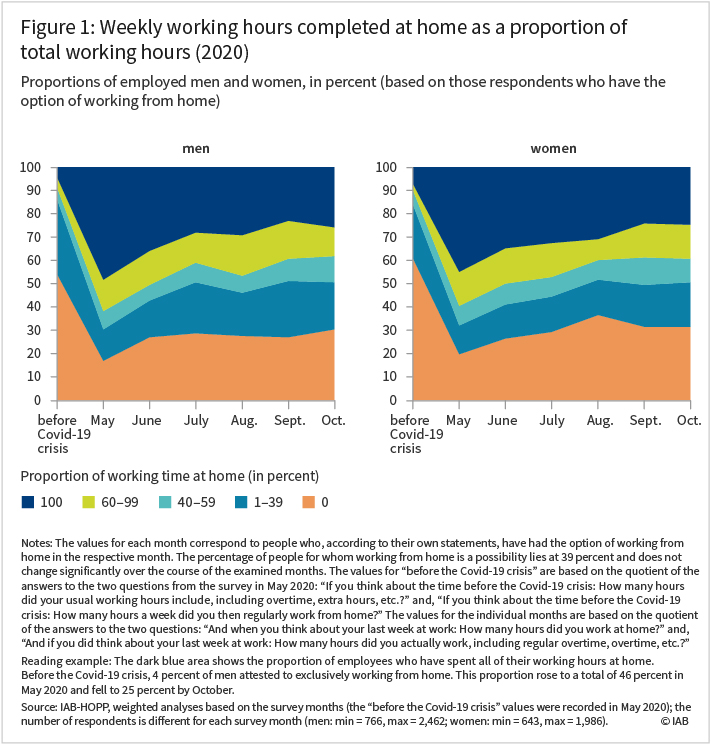
Satisfaction with the level of working from home
The data from the additional Corona survey conducted by the Linked Personnel Panel can also be used to examine satisfaction with the level of working from home. The Panel is representative of establishments in the private sector with at least 50 employees subject to social security contributions, so that corresponding evaluations are valid for employees of these establishments. Despite the decrease in working from home as a share of total working time in the summer and autumn of 2020, around three quarters of users remained satisfied with the amount which they could work from home. Here, the scope of working from home seems to have been based on the expectations and demands of the employees, for example in the form of optional decisions regarding the choice of work location.
In addition, the desire to work more from home increased somewhat (from 8 % to 13 %), while the desire to work less from home decreased (from 18 % to 12 %). This occurred during a period in which the average level of work conducted from home was decreasing.
Women have switched much more frequently to working from home
Since 2012, employees have been surveyed regularly about the use of working from home within the Linked Personnel Panel. This allows individual biographies to be illustrated which indicate whether a person has worked entirely on-site or at least partially from home. Figure 2 shows the four most common types of biography. The first line shows the employees who have worked exclusively on-site since 2017: half of men (49 %) and a third of women (33 %). The second line shows those who have consistently spent at least part of their hours spent working from home since 2017: roughly a fifth for both men and women.
In the current debate, however, the most substantial are those who only switched to working from home either completely or temporarily at the beginning of the pandemic (third line): 9 percent of men and 34 percent of women. A reason may be a greater (unfulfilled) desire to work from home in 2019 amongst women than among men. In addition, data from the Linked Personnel Panel show that during school and daycare closures, mothers with caring responsibilities more often worked from home than fathers as described by Corinna Frodermann et al. in their 2020 study. However, similar to those biographies without any working from home, differences in job tasks and the associated feasibility of working from home are likely to play a major role in the large difference between men and women.
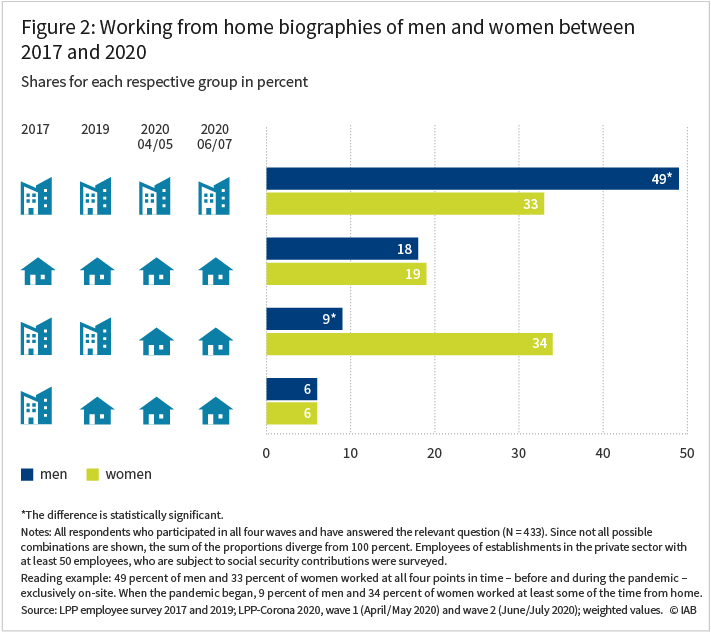
Many barriers have been greatly reduced
Earlier studies, such as by Philipp Grunau et al. from 2020, were able to show that the potential of working from home before the Covid-19 pandemic was far from exhausted. Although they were, in principle, not location-dependent, a considerable proportion of work activities took place on-site. Reasons were often technical hurdles as well as cultural reservations from employers, superiors, and the employees themselves.
We focus on obstacles that may be removed in the short or medium term by employers and that played a substantial role before the pandemic (see Figure 3). If the work-activity is suitable or not is not included.
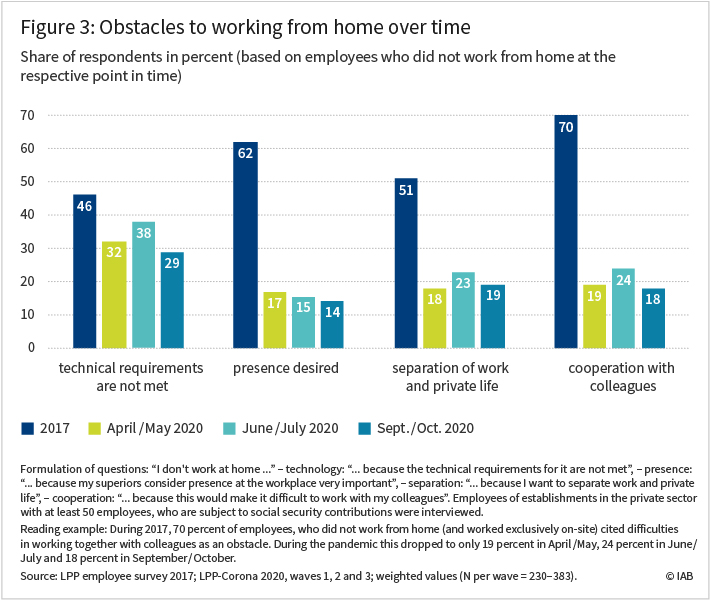
The data from 2020 reveal a picture that is not surprising: although technical hurdles have been substantially reduced, in September/October 2020 they still existed for almost 30 percent of employees without access to working from home. This underlines the fact that in many cases it is not possible to remove technical obstacles in the short term.
In contrast to this, almost all “soft” obstacles, i.e. reservations by establishments, superiors, or employees, could be put aside at short notice. In April/May 2020, only around 17 percent of employees who did not use working from home stated that they did not do so due to a culture of presence in the workplace; in 2017, this proportion amounted to over 60 percent. The separation of work and private life only got in the way in 18 percent of cases in April/May 2020. The decline was most pronounced in relation to perceived problems around collaborating with colleagues: 19 percent of employees named this as an obstacle in April/May 2020 – compared to 70 percent in 2017. As many employees were forced from one day to the next to deal intensively with new virtual exchange formats, learning and familiarization effects may play a bigger role here.
Working from home is generally viewed positively
In the Covid-19 pandemic, the relocation of work to one’s own four walls was often initiated by employers and therefore did not always meet the wishes of the employees. Therefore, the question arises as to how employees fared in working from home.
The HOPP-data from August 2020 reveal that, at 61 percent, the overwhelming majority of employees who worked wholly or partially from home perceived this as helpful and less burdensome (see Figure 4). For around 13 percent, on the other hand, working from home was rather negligible; they found working from home neither helpful nor burdensome.
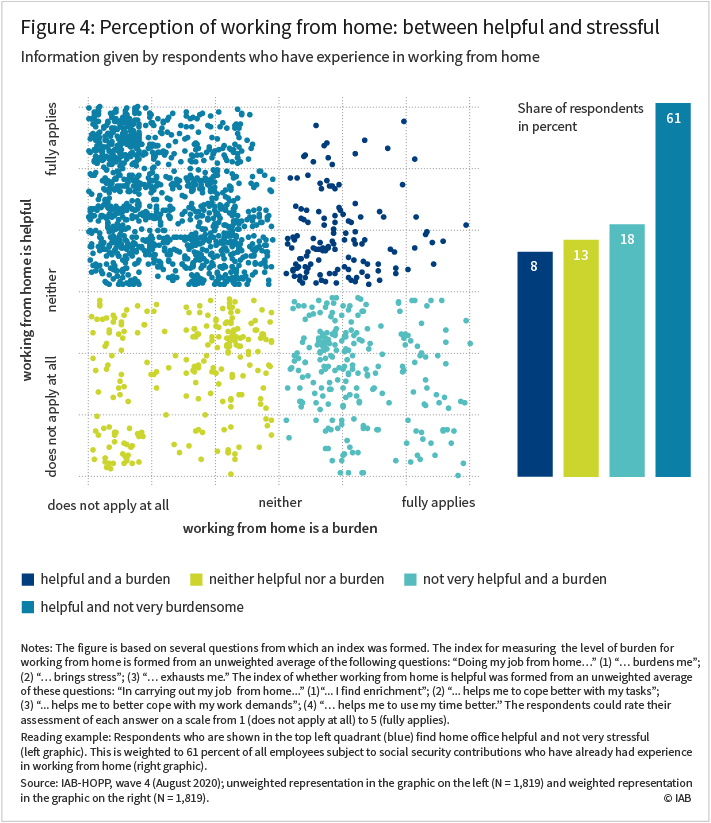
In particular, we see an increased burden of working from home in the other two groups: around 8 percent perceived working from home as helpful, but also felt that it was a burden. The situation seems to be the most difficult for the remaining almost 18 percent, who reported that working from home was a burden and not helpful.
Employees who had worked from home before the pandemic rated working from home – on a scale from 1 (does not apply at all) to 4 (applies completely) – on average as more helpful for handling their work tasks (3.1), than employees who only switched to working from home at the beginning of the pandemic (2.8). Whether or not working from home is perceived as a burden remains unaffected by this. This indicates either a learning curve – that the advantages of working from home only become clear with increasing experience – or that employees who worked from home to a greater extent before the pandemic have a job that is very well suited to working from home.
Women find working from home slightly more burdensome than men (2.1 versus 1.9), but it makes no difference whether children live in the household or not. By contrast, the perceived burden is higher in women if they have relatives living in the household who require care (2.4).
With regard to gender and the fact that children or relatives who need to be cared for live in the household, our data show no differences in how helpful working from home is perceived in handling work tasks from home.
Workplace at home between kitchen table and separate study
Workplace equipment is certainly a prerequisite for efficient working from home. In the additional Corona survey by the Linked Personnel Panel in October, two thirds of users (67 %) stated that they have a permanent workspace at home, mostly even in a separate room or study (42 %). In contrast, however, just under a third (31 %) of employees mainly work at the dining- or kitchen table.
The figures illustrate the need for long-term solutions for workplace equipment in home offices – also for the time after the pandemic. Particularly when working regularly and extensively from home, certain workplace equipment is important and must meet the standards prescribed in workplace regulations. This is not only important for reasons of efficiency, but also helps to prevent long-term damage to health.
Opportunities and risks of working from home
During the pandemic, the benefits and opportunities of working from home are also offset by risks. On the one hand, working from home brings a potentially better work-life balance, the elimination of commuting, and greater flexibility in terms of time as well as more autonomy. On the other hand, the blurring of temporal and spatial boundaries can lead to working overtime. In addition, with an increase in the proportion of work done at home, personal contact with superiors and colleagues may suffer, and feelings of social isolation or health problems may arise. Furthermore, there are indications as described in a study by Nicholas Bloom et al. from 2015 that intensive working from home use can have a detrimental effect on promotion opportunities.
Desired scope of working from home post-pandemic
The evaluations of the HOPP data from August 2020 show that the majority of employees are in favour of regularly working from home use once the pandemic is over, with two (18 %) and three days (14 %) per week working from home being the most popular after the “flexible, as required” answer category (37 %) (see Figure 5). A differentiated analysis of the survey data for full-time and part-time employees shows no difference between these two groups. Overall, only a comparatively small proportion (7 %) would like to work exclusively from home, that is, five days a week in future. In contrast, the majority of employees who do not have the opportunity to work from home also do not have a wish to (52 %).
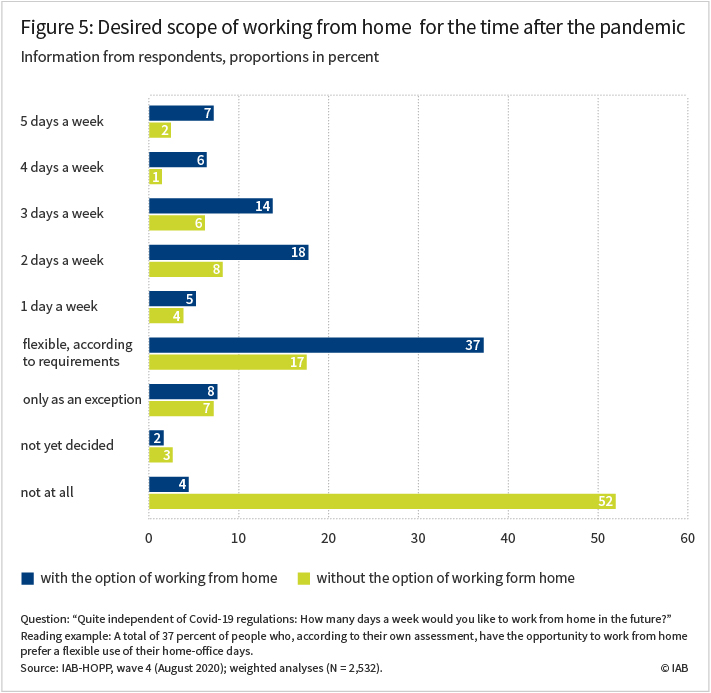
Future working from home from an employer’s point of view
From the point of view of employers, working from home can certainly offer advantages: in addition to potential increases in productivity, costs may be saved that can be attributed to a lower requirement for office space and lower employee turnover. Initial indications as to whether establishments want to maintain the expanded offer of working from home and meet the wishes of their employees are shown by the results of the establishment survey “Establishments in the Covid-19 crisis” by the IAB. Results indicate that of the establishments that generally offer their employees the opportunity to work from home, 67 percent want to return to the same extent as before the pandemic.
Conclusion
The findings presented show that since the beginning of the Covid-19 pandemic, significantly more employees work exclusively or partially from home and, in particular, that many women have switched to working from home for the first time. The overwhelming majority were satisfied with this, despite the sometimes high proportion of work being done from home.
In the future, almost all employees whose job is suited to working from home would like to do a certain proportion of their work at home. The majority would want to use it regularly, often wanting to work from home two or three days per week. In contrast, only a few would like a complete return to on-site work.
It can therefore be assumed that as the pandemic subsides, the level of working from home will decrease somewhat from its currently very high level. However, making working hours and work-location more flexible is likely – for at least some of the employees – to play a greater role in the future than prior to the pandemic.
Data base
For this article, we use data from the High-frequency Online Personal Panel (HOPP) “Life and Work Situations in Times of Corona” and the additional Coronavirus survey of the Linked Personnel Panel (LPP). These surveys of the German Institute for Employment Research (IAB) contribute to provide data on the changes in the social and work life in the context of the Covid-19 pandemic on a short-term basis and to allow an investigation of the effects of the crisis in the long run.
Survey “Life and Work Situations in Times of Corona” (HOPP)
For this online survey, persons have been drawn from a proportional stratified random sample from the Integrated Employment Biographies (Integrierte Erwerbsbiografien – IEB) of the IAB of the year 2018, and then interviewed since May 2020. The IEB are based on administrative data of the Federal Employment Agency (Bundesagentur für Arbeit – BA) and cover all episodes of employment subject to social security contributions and of marginal employment, of receiving “Unemployment Benefits” and “Unemployment Benefits II”, of job search and unemployment, of participation in labour market policy measures that were administered by the Federal Employment Agency. By means of the collected data it is possible to make representative statements for the working-age population in Germany. If interviewees agreed to being interviewed again, they were invited to follow-up surveys regularly. Survey questions repeat over waves, in order to measure changes over the time. Additionally each wave contains a set of questions that focuses on one specific labour market topic. For more details on this survey, please refer to the study by Georg-Christoph Haas et al. from 2021. The data used here come from the first five interview waves from the months of May, June, July, August, September, and October 2020.
Additional Coronavirus Survey of the Linked Personnel Panel (LPP)
The basis for this online survey is the Linked Personnel Panel (LPP), which consists of a longitudinal survey of German establishments in the private sector with at least 50 employees subject to social security contributions, and interviews of randomly selected employees of these organisations. The two primary surveys have been carried out alternately since 2012. For more details on this survey, please refer to the study by Kevin Ruf et al. from the year 2020. In 2019, 85 percent (5,526) of the interviewees in the LPP Employee Survey stated that they use digital information and communication technologies for their work, such as computers, laptops, tablets, or smartphones. Of these, 2,103 persons have agreed to participate in another interview, taking place outside the regular biennial rhythm. They form the gross sample for the online survey during the pandemic. The first survey wave was carried out in April and May 2020 (1,212 interviewees), the second one in June and July 2020 (909 interviewees), and the third survey wave was carried out in September and October 2020 (682 interviewees). No further waves were carried out, because the next – fifth – regular LPP Employee Survey is conducted since March 2021. The results presented are weighted and can be conferred to the statistical population of all employees subject to social security contributions who a) use digital information and communication technology in their work, and b) work in establishments in the private sector with at least 50 employees subject to social security contributions. This applies to approximately 40 percent of the employees subject to social security contributions.
Literature
Bloom, Nicholas; Liang, James; Roberts, John; Ying, Zhichun Jenny (2015): Does working from home work? Evidence from a Chinese experiment. In: The Quarterly Journal of Economics, Vol. 130, Issue 1, pp. 165–218.
Frodermann, Corinna.; Grunau, Philipp; Haas, Georg-C.; Müller, Dana (2021): Homeoffice in Zeiten von Corona: Nutzung, Hindernisse und Zukunftswünsche. IAB-Kurzbericht, No. 5.
Haas, Georg-Christoph.; Müller, Bettina; Osiander, Christopher. (2021): Development of a new COVID-19 panel survey: the IAB high-frequency online personal panel (HOPP). In: Journal of Labour Market Research, Vol. 55.
Ruf, Kevin; Mackeben, Jan; Grunau, Philipp; Wolter, Stefanie. (2020): A unique employer-employee study: the Linked Personnel Panel (LPP). Design, extensions and research potential. In: Jahrbücher für Nationalökonomie und Statistik, Vol. 240, No. 1, pp. 133–145.
Frodermann, Corinna; Grunau, Philipp ; Müller, Dana ; Haas, Georg-Christoph (2021): Working from home during the Covid-19 pandemic: usage, barriers, and wishes for the future, In: IAB-Forum 30th of July 2021, https://www.iab-forum.de/en/working-from-home-during-the-covid-19-pandemic-usage-barriers-and-wishes-for-the-future/, Retrieved: 19th of April 2024
Authors:
- Corinna Frodermann
- Philipp Grunau
- Dana Müller
- Georg-Christoph Haas

 Dr Corinna Frodermann is senior researcher in the department "Panel Study Labour Market and Social Security" at the IAB and at the Research Data Centre of the Federal Employment Agency at the Institute for Employment Research.
Dr Corinna Frodermann is senior researcher in the department "Panel Study Labour Market and Social Security" at the IAB and at the Research Data Centre of the Federal Employment Agency at the Institute for Employment Research. Dr Philipp Grunaun is a senior researcher in the department "Establishments and Employment" at the IAB.
Dr Philipp Grunaun is a senior researcher in the department "Establishments and Employment" at the IAB. Dana Müller is head of the Research Data Centre (FDZ) of the Federal Employment Agency (BA) at the Institute for Employment Research (IAB).
Dana Müller is head of the Research Data Centre (FDZ) of the Federal Employment Agency (BA) at the Institute for Employment Research (IAB). Georg-Christoph Haas is a researcher in the department “Statistical Methods” at the IAB.
Georg-Christoph Haas is a researcher in the department “Statistical Methods” at the IAB.